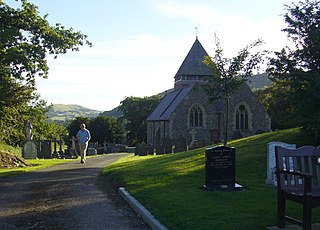
Llandinam is a village and community in Montgomeryshire, Powys, central Wales, between Newtown and Llanidloes, located on the A470. As a community, Llandinam is made up of the village itself, small hamlets including Plas Dinam and Little London and several farms. The village itself has a population of around 576 with 56% born in Wales.

Magor is a large village in Monmouthshire, south east Wales, about 9 miles (14 km) west of Chepstow and about 9 miles (14 km) east of Newport. It lies on the Caldicot Levels beside the Severn Estuary, and is in the community of Magor with Undy. Magor lies close to the M4 motorway.

St. Brides Netherwent is a parish and largely deserted village in Monmouthshire, south-east Wales. It is centred 2 miles north of Magor, and 3 miles west of Caerwent. The A48 Newport to Chepstow road passes close by to the north.
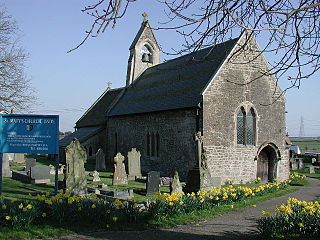
Undy is a village in Monmouthshire, south east Wales, adjoining the village of Magor with which it forms the community and parish of Magor with Undy. It is located about 3 miles (4.8 km) west of Caldicot and 10 miles (16 km) east of Newport, close to the junction of the M4 and M48 motorways, and adjoins the Caldicot Levels on the north bank of the Bristol Channel.
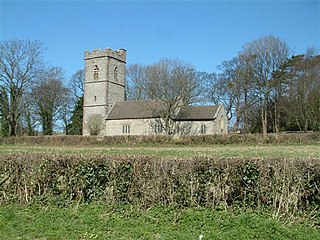
Bishton or Bishopston is a small rural community in the east of the city of Newport, South Wales. It lies in the Llanwern electoral district (ward) and contains the eastern end of Llanwern steelworks, the Underwood estate as well as Bishton itself. The population in the 2001 census was 2,181; dropping to 2,137 in 2011.

Redwick is a small village and community (parish) to the south east of the city of Newport, in Wales, United Kingdom. It lies within the Newport city boundaries, in the historic county of Monmouthshire and the preserved county of Gwent. in 2011 the population was 206.

The Priory Church of St Mary, Abergavenny is a parish church in the centre of Abergavenny in Monmouthshire, Wales.

St Garmon's Church is in the centre of the village of Llanarmon-yn-Iâl, Denbighshire, Wales. It is an active Anglican church in the diocese of St Asaph, the archdeaconry of St Asaph and the deanery of Dyffryn Clwyd. It is designated by Cadw as a Grade I listed building.
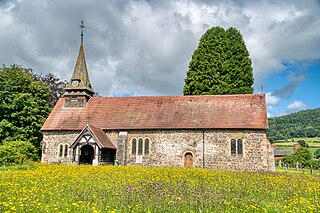
St Garmon's Church, Llanfechain, is in the village of Llanfechain, Powys, Wales. It is an active Anglican parish church in the deanery of Llanfyllin, the archdeaconry of Montgomery, and the diocese of St Asaph, and is designated by Cadw as a Grade II* listed building. The church is traditionally associated with a 9th-century Celtic saint, St Garmon. St Garmon was most likely St Germanus (410–474), the first Bishop of Man. It shares it name with the church in the village of St Harmon in Radnorshire (Powys), where the diarist Francis Kilvert was a curate.

St Pabo's Church, Llanbabo is a medieval church in Llanbabo, in Anglesey, North Wales. Much of the church dates to the 12th century, and it is regarded as a good example of a church of its period that has retained many aspects of its original fabric. The church houses a tombstone slab from the 14th century, depicting a king with crown and sceptre, bearing the name of Pabo Post Prydain, the reputed founder of the church. However, there is no evidence that Pabo, a 5th-century prince, lived in the area and the tradition that he founded the church has little supporting basis.
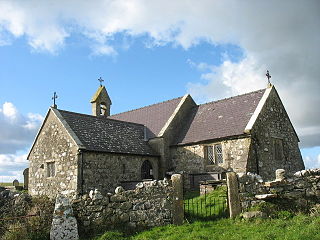
St Peulan's Church, Llanbeulan is a redundant Anglican church in Llanbeulan, in Anglesey, north Wales. The nave, which is the oldest part of the building, dates from the 12th century, with a chancel and side chapel added in the 14th century. The church has a font of early date, possibly from the first half of the 11th century: one historian has said that it would initially have been used as an altar and that "as an altar of the pre-Norman period it is a unique survivor in Wales and, indeed, in Britain".

St Peirio's Church is a small disused medieval church, in Rhosbeirio, Anglesey, north Wales. It is unclear when a church was first established on this site, although it has been said that this happened in about 605. The current structure, which may date from the 15th century, has been restored in the 18th and 19th centuries. It ceased being used for services some years ago and has been boarded up.

St Tyfrydog's Church, Llandyfrydog is a small medieval church, in Llandyfrydog, Anglesey, north Wales. The date of establishment of a church on this site is unknown, but one 19th-century Anglesey historian says that it was about 450. The oldest parts of the present building are dated to about 1400, with the chancel dating from the late 15th or early 16th century. It is built from rough, small, squared stones, dressed with limestone. One of the windows on the south side is raised to illuminate the pulpit, a decision that in the eyes of one 19th-century commentator "disfigures the building."

St Gallgo's Church, Llanallgo is a small church near the village of Llanallgo, on the east coast of Anglesey, north Wales. The chancel and transepts, which are the oldest features of the present building, date from the late 15th century, but there has been a church on the site since the 6th or early 7th century, making it one of the oldest Christian sites in Anglesey. Some restoration and enlargement took place during the 19th century.

Magor railway station is a former station serving Magor, Monmouthshire, east of the city of Newport and west of Caldicot. It was opened as a broad gauge line with the South Wales Railway in 1850 and closed to passengers in 1964. The line was quadrupled in 1941.

The Church of St Mary stands in the centre of the village of Magor, Monmouthshire, Wales. It was designated a Grade I listed building in 1963. The church is the lead church of the Netherwent Ministry Area, led by Rev. Canon Jeremy Harris, and administers to a population of around 32,000.

St Peter's Church, Llanbedrgoch, is a small medieval parish church near the village of Llanbedrgoch in Anglesey, north Wales. The oldest parts of the building date from the 15th century; it was extended in the 17th century and restored twice in the 19th century. The doorway is decorated with carvings of two human heads, one wearing a mitre. The church contains a reading desk made from 15th-century bench ends, one carved with a mermaid holding a mirror and comb.
Magor with Undy is a community on the coast of the Severn Estuary in Monmouthshire, Wales. It includes the villages of Magor and Undy.
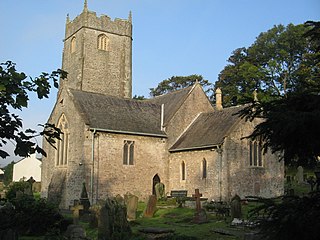
The Church of St John the Baptist is a medieval church in Llanblethian in the Vale of Glamorgan, south Wales. Believed to have been built in the 12th century, the church boasts an unusual tower, consistent with the style more common in the south west of England. It underwent extensive restoration in the late 19th century, undertaken by C. B. Fowler of Cardiff. The Church of St John was listed as a Grade I building on 22 February 1963.

The Procurator's House in Magor, Monmouthshire, Wales, is a large, ruined mansion of the sixteenth-century, standing next to St Mary's Church in the centre of the village. Although of ecclesiastical origin, it is unlikely the present house was ever occupied by a Procurator, who was a church official responsible for the collection of tithes. The lands owned by the Church of St Mary were controlled by the Abbey of Anagni, in Italy, in the Middle Ages and it is possible that an earlier building on the same site housed the abbey's procurator. The current building post-dates ownership by the abbey, and was constructed when the avowson of St Mary's was controlled by Tintern Abbey. The building is mentioned in a document of 1585, when it is referred to as "the mansion house belonging to the vicarage of Magor." This accounts for the two alternative names for the ruin, Magor Mansion and The Church House.




















